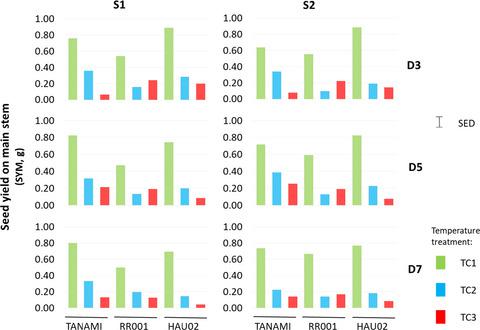当前位置:
X-MOL 学术
›
Food Energy Secur.
›
论文详情
Our official English website, www.x-mol.net, welcomes your
feedback! (Note: you will need to create a separate account there.)
Transient daily heat stress during the early reproductive phase disrupts pod and seed development in Brassica napus L.
Food and Energy Security ( IF 4.0 ) Pub Date : 2020-11-06 , DOI: 10.1002/fes3.262 Sheng Chen 1, 2 , Katia Stefanova 1 , Kadambot H. M. Siddique 1, 2 , Wallace A. Cowling 1, 2
Food and Energy Security ( IF 4.0 ) Pub Date : 2020-11-06 , DOI: 10.1002/fes3.262 Sheng Chen 1, 2 , Katia Stefanova 1 , Kadambot H. M. Siddique 1, 2 , Wallace A. Cowling 1, 2
Affiliation

|
Transient daily heat stress during flowering of canola (Brassica napus L.) as a result of global warming is an increasing threat to grain production in this important oilseed crop. We investigated the intensity and duration of transient daily heat stress treatment at different stages of reproductive development in three B. napus genotypes under controlled environment conditions. Heat stress treatments during the week before first open flower on the main stem (S0) or during the first week (S1) or second week (S2) following first open flower greatly reduced pod number and seed yield on the main stem. Heat stress treatment during the third week (S3), fourth week (S4), or fifth week (S5) reduced seed yield more on the branches and less on the main stem as time progressed. Pod number and seed yield were reduced by moderate heat stress (TC2; 32°C/22°C) and high heat stress (TC3; 35°C/25°C), compared with the control (TC1, 25°C/15°C). Each duration of heat stress treatment (3, 5 or 7 days) caused the same reduction in pod number and seed per pod on the main stem. Leaf stomatal conductance, leaf chlorophyll index, plant height, and dry weight of above‐ground biomass increased from TC1 to TC3, which indicates that heat stress in the absence of drought stress does not inhibit vegetative growth. Cool night temperatures (15°C) resulted in recovery of pod number and seed yield after moderate (32°C) but not high (35°C) daily transient heat stress. The range of genotype responses to heat stress was greater under TC2 than under TC3. This research brings forward the critical period for heat stress sensitivity in B. napus to one week before first open flower and defines the conditions for controlled environment screening for heat tolerance in B. napus.
中文翻译:

生殖早期的瞬时每日热应激破坏了甘蓝型油菜的荚果和种子发育。
由于全球变暖,油菜(油菜)开花期间的瞬时每日热应激对该重要油料作物的谷物生产构成越来越大的威胁。我们调查了三个甘蓝型油菜生殖发育不同阶段的瞬时每日热应激处理的强度和持续时间。受控环境条件下的基因型。在主茎上开第一朵花之前的一周内(S0)或在第一朵开放花后的第一周(S1)或第二周(S2)期间进行热胁迫处理,大大降低了主茎上的豆荚数量和种子产量。随着时间的推移,在第三周(S3),第四周(S4)或第五周(S5)进行的热胁迫处理会减少树枝上的种子产量,而减少主茎上的种子产量。与对照(TC1,25°C / 15)相比,中度热胁迫(TC2; 32°C / 22°C)和高热胁迫(TC3; 35°C / 25°C)降低了荚果数量和种子产量°C)。热应激处理的每个持续时间(3、5或7天)都会导致主茎上每个荚果的荚果数量和种子减少相同。叶片气孔导度,叶片叶绿素指数,株高,地上生物量的干重从TC1增加到TC3,这表明在没有干旱胁迫的情况下,热胁迫不会抑制营养生长。凉爽的夜间温度(15°C)使中度(32°C)但不高(35°C)的每日瞬态热胁迫后荚果数量和种子产量的恢复。基因型对热应激的反应范围在TC2下比在TC3下更大。本研究提出了高温胁迫敏感性的关键期。甘蓝型油菜(B. napus)至首次开花前一个星期,并确定了可控环境筛选甘蓝型油菜耐热性的条件。
更新日期:2020-11-06
中文翻译:

生殖早期的瞬时每日热应激破坏了甘蓝型油菜的荚果和种子发育。
由于全球变暖,油菜(油菜)开花期间的瞬时每日热应激对该重要油料作物的谷物生产构成越来越大的威胁。我们调查了三个甘蓝型油菜生殖发育不同阶段的瞬时每日热应激处理的强度和持续时间。受控环境条件下的基因型。在主茎上开第一朵花之前的一周内(S0)或在第一朵开放花后的第一周(S1)或第二周(S2)期间进行热胁迫处理,大大降低了主茎上的豆荚数量和种子产量。随着时间的推移,在第三周(S3),第四周(S4)或第五周(S5)进行的热胁迫处理会减少树枝上的种子产量,而减少主茎上的种子产量。与对照(TC1,25°C / 15)相比,中度热胁迫(TC2; 32°C / 22°C)和高热胁迫(TC3; 35°C / 25°C)降低了荚果数量和种子产量°C)。热应激处理的每个持续时间(3、5或7天)都会导致主茎上每个荚果的荚果数量和种子减少相同。叶片气孔导度,叶片叶绿素指数,株高,地上生物量的干重从TC1增加到TC3,这表明在没有干旱胁迫的情况下,热胁迫不会抑制营养生长。凉爽的夜间温度(15°C)使中度(32°C)但不高(35°C)的每日瞬态热胁迫后荚果数量和种子产量的恢复。基因型对热应激的反应范围在TC2下比在TC3下更大。本研究提出了高温胁迫敏感性的关键期。甘蓝型油菜(B. napus)至首次开花前一个星期,并确定了可控环境筛选甘蓝型油菜耐热性的条件。











































 京公网安备 11010802027423号
京公网安备 11010802027423号